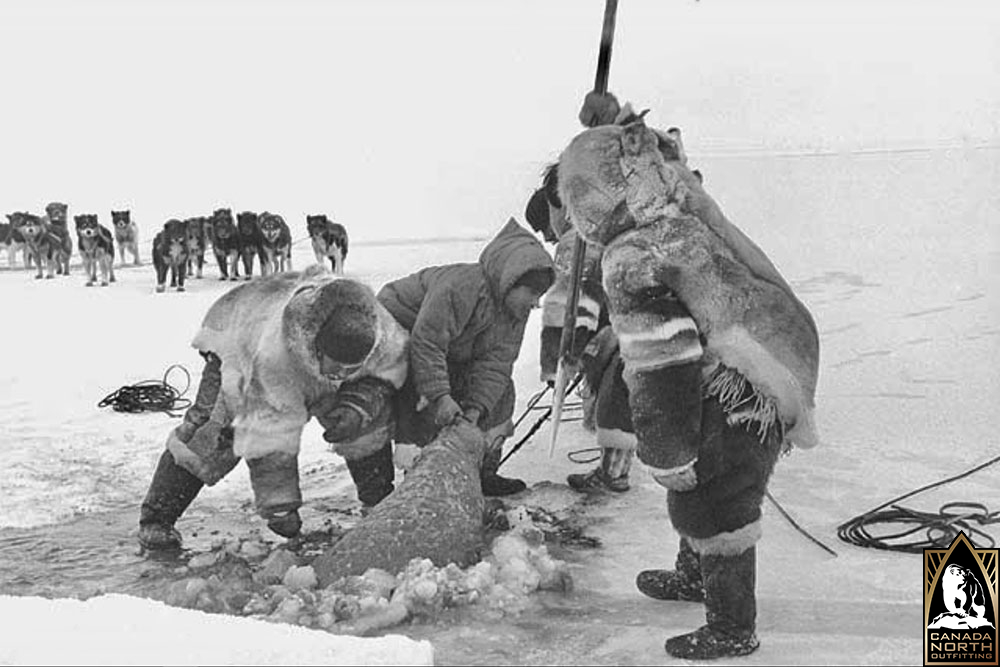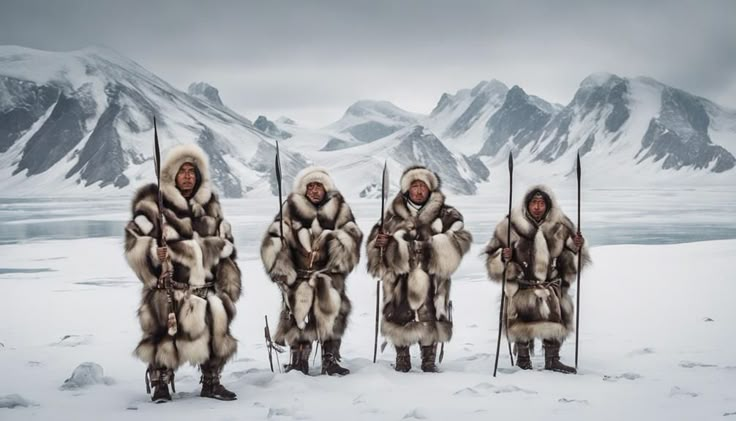
Mastering the Ice: The Unparalleled Survival Wisdom of the Inuit
The Arctic, a vast, unforgiving expanse of ice, snow, and bone-chilling cold, remains one of Earth’s most extreme environments. To the untrained eye, it appears barren, desolate, and utterly inhospitable to human life. Yet, for millennia, a remarkable people – the Inuit – have not merely survived but thrived within its icy embrace. Their story is a profound testament to human ingenuity, resilience, and an unparalleled understanding of the natural world. Far from being a struggle against nature, the Inuit’s existence in the Arctic is a symphony of adaptation, a meticulously crafted system of survival techniques that stand as a beacon of human capability in the face of daunting adversity.
Their survival is not a matter of luck, but the culmination of generations of accumulated wisdom, passed down through oral traditions, practical demonstrations, and an intimate connection with every nuance of their environment. From the ingenious design of their dwellings to their sophisticated hunting methods and revolutionary clothing, the Inuit developed a holistic approach to living where every element was precisely tailored to the harsh realities of the polar regions.

The Second Skin: A Masterclass in Arctic Attire
The first line of defense against the Arctic’s brutal cold is clothing, and the Inuit perfected it long before modern insulation. Their traditional attire was not just warm; it was a sophisticated, multi-layered system designed to trap heat, wick moisture, and allow for ventilation, all while being lightweight enough for active hunting and travel.
The cornerstone of their wardrobe was caribou hide. "Every hair on a caribou hide is hollow," explains Dr. Max Friesen, an Arctic anthropologist, "making it an exceptional insulator. It’s like wearing a thousand tiny thermos bottles." This natural insulation, combined with a crucial layering strategy, created an unparalleled warmth. The amauti, a traditional Inuit parka, often consisted of two layers: an inner parka with the fur facing inward, and an outer parka with the fur facing outward. This created an insulating air pocket between the layers, trapping warmth effectively. The loose fit allowed for air circulation, preventing overheating during strenuous activity and subsequent chilling from sweat.
Seal skin was another vital material, particularly for outer layers and footwear. Its natural water-repellent properties made it ideal for boots (kamiks) and mittens, protecting against wet snow and slush. Animal sinew was used as thread, and needles were crafted from bone or ivory. The preparation of these materials was an art in itself, involving scraping, tanning, and meticulously sewing to create garments that were both functional and beautiful. This "second skin" was not just clothing; it was a portable shelter, a vital extension of their survival strategy.
Architects of Ice: The Igloo and Beyond
When one imagines Inuit survival, the iconic igloo immediately comes to mind. More than just a snow hut, the igloo is a marvel of indigenous engineering, a testament to understanding the thermal properties of snow and ice. Constructed from blocks of compressed snow, the igloo’s dome shape is incredibly strong, capable of withstanding fierce winds. Its true genius lies in its insulation. Snow, composed of tiny air pockets, is an excellent insulator. Inside, a single seal oil lamp (qulliq) could raise the temperature significantly, often to above freezing, while outside temperatures plummeted to -50°C.
The design incorporated a lower entrance tunnel, which acted as a "cold trap," preventing warm air from escaping and cold air from entering directly. A small ventilation hole at the top allowed for fresh air and prevented carbon monoxide buildup from lamps. "The igloo is not just a dwelling; it’s a dynamic environment, breathing with its occupants, designed to maintain a delicate balance with the extreme cold," notes Arctic explorer and historian, Russell Potter. While often depicted as permanent homes, igloos were primarily used as temporary shelters during hunting trips or winter travel.
For summer months, the Inuit relied on tupiqs, tents made from caribou or seal skins stretched over a wooden or bone frame. These lighter, portable shelters were perfectly suited for the warmer, more mobile lifestyle of summer hunting and fishing.

The Sustenance of the Land: Hunting and Food Preservation
In a landscape seemingly devoid of vegetation, the Inuit’s diet was almost exclusively meat-based, a testament to their exceptional hunting skills and deep knowledge of animal behavior. Seals were paramount, providing not only nutrient-rich meat and vital blubber (for fat, energy, and oil for lamps), but also skin for clothing and tools, and bones for implements. Hunters developed an uncanny ability to locate seal breathing holes in the ice, waiting patiently for hours, sometimes days, for their prey to surface.
Whales, particularly the Bowhead and Narwhal, provided massive quantities of food, blubber, and materials, often hunted communally in large umiaks (open skin boats). Caribou were hunted on land for their meat, hides, and antlers. Fish, particularly Arctic char, were caught through ice holes or with nets in summer.
A crucial aspect of their survival was food preservation. Given the unpredictable nature of hunting, storing surplus was essential. Meat was often dried into a form similar to jerky, sometimes mixed with fat and berries to create a nutritious, long-lasting pemmican-like substance. Fermentation was also used, as seen in the infamous kiviak, where small birds are encased whole in a seal skin and left to ferment for months, creating a potent, vitamin-rich delicacy.
Despite a lack of plant-based foods, the Inuit rarely suffered from scurvy or other nutritional deficiencies. They obtained essential vitamins, including Vitamin C, from raw meat, organ meats (especially liver), and the skin and blubber of marine mammals. "They understood intuitively what modern science later confirmed: that fresh, raw animal products, especially organ meats, contain the necessary nutrients to sustain life in such an environment," says nutritionist Dr. Susan A. C. B. Hetherington.
Ingenious Tools and Transportation
The Arctic environment demanded highly specialized tools. The ulu, a crescent-shaped knife, was an indispensable tool for Inuit women, used for skinning animals, cutting meat, preparing hides, and even cutting hair. Its unique design allowed for an efficient rocking motion, ideal for precise cuts.
Harpoons were meticulously crafted with detachable heads and retrieving lines, designed to penetrate thick blubber and allow the hunter to hold onto their catch. Simple yet effective tools like snow knives, made from bone or antler, were used to cut snow blocks for igloos.
Transportation was key to covering vast distances. The kayak, a nimble, enclosed skin boat, was a hunter’s stealthy vessel, allowing them to approach marine mammals silently. The larger umiak, an open skin boat, was used for transporting families, supplies, and for communal whale hunting.
On land, the qamutiik, or dog sled, was the primary mode of transport. Inuit dogs (later known as Canadian Inuit Dogs or Greenland Dogs) were powerful, resilient, and intelligent companions, capable of pulling heavy loads over challenging terrain for long distances. The symbiotic relationship between the Inuit and their dogs was fundamental to their mobility and hunting success.
Navigating the Featureless Expanse
One of the most remarkable aspects of Inuit survival was their ability to navigate across vast, seemingly featureless landscapes of snow and ice. Without maps or compasses, they relied on an intricate understanding of natural cues. The sun’s position, even when low on the horizon, provided direction. The stars, particularly Polaris, were constant guides.
They could discern direction from subtle changes in wind patterns, the shape and texture of snowdrifts (which are formed by prevailing winds), the type of ice formations, and even the smell of open water or seal breathing holes. "Their navigation wasn’t about technology; it was about an deep, almost spiritual connection to the land and its subtle messages," states traditional knowledge keeper, Taamusi Qumak. This intuitive, multi-sensory navigation system allowed them to travel safely and purposefully across what outsiders perceived as an undifferentiated white void.
The Power of Community and Oral Tradition
Beyond the tangible tools and techniques, the bedrock of Inuit survival was their social structure and the power of communal living. Life in the Arctic was too challenging for individualistic survival. Hunting was often a communal effort, and resources were shared equitably within the community. Cooperation, generosity, and mutual support were not just virtues but necessities for survival.
Knowledge was passed down through generations via rich oral traditions, storytelling, and direct mentorship. Children learned by observing and participating from a young age, acquiring the complex skills needed for hunting, building, and navigating. This continuous transmission of knowledge ensured the perpetuation of their survival wisdom.
Enduring Legacy and Modern Challenges
Today, the Inuit face new challenges, most notably climate change, which is rapidly altering the Arctic landscape they know so intimately. Traditional hunting grounds are changing, ice is thinning, and familiar animal migration patterns are disrupted. Modern conveniences have also brought changes to traditional lifestyles.
Yet, the spirit of Inuit resilience and adaptation endures. There is a strong movement to preserve and revitalize traditional knowledge, language, and cultural practices. The ancient wisdom of Arctic survival techniques is not just a historical curiosity; it is a profound lesson in sustainable living, resourcefulness, and the enduring power of human adaptation. The Inuit remind us that survival is not just about overcoming obstacles, but about living in profound harmony with the world, even its harshest corners. Their story is a powerful testament to the extraordinary capacity of humanity to not just exist, but to thrive, in the most challenging environments on Earth.


